- Like
- SHARE
- Digg
- Del
- Tumblr
- VKontakte
- Flattr
- Buffer
- Love This
- Save
- Odnoklassniki
- Meneame
- Blogger
- Amazon
- Yahoo Mail
- Gmail
- AOL
- Newsvine
- HackerNews
- Evernote
- MySpace
- Mail.ru
- Viadeo
- Line
- Comments
- Yummly
- SMS
- Viber
- Telegram
- JOIN
- Skype
- Facebook Messenger
- Kakao
- LiveJournal
- Yammer
- Edgar
- Fintel
- Mix
- Instapaper
- Copy Link
 If You Only had Time to do Four Exercises
If You Only had Time to do Four Exercises
If you say, “There is no way around it, no matter how I juggle my schedule, I just can’t find an hour to devote to working out,” then you need not fear, for there are four exercises you can do in this time that will train your entire body– dead-lift, squats, pull-ups, and dips.
First, we will look at each one of these exercises in depth, and then some ideas will be given on how you can put these exercises together to both ensure you are continually challenging yourself to make the most efficient use of your time, and to keep it interesting and fun so you stay motivated and consistent.
Deadlift
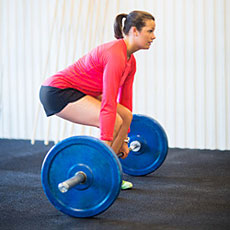 From your toes to your head, dead-lifts recruit more muscles to a greater intensity than any other exercise. Power lifters, Olympic lifters, bodybuilders and athletes all use this exercise as it builds explosive power, core and grip strength.
From your toes to your head, dead-lifts recruit more muscles to a greater intensity than any other exercise. Power lifters, Olympic lifters, bodybuilders and athletes all use this exercise as it builds explosive power, core and grip strength.
There are a number of variations to the performance of this exercise (e.g., straight-legged, dumbbell, etc.) and you can incorporate these later to add variety to your workouts, but for this article we will discuss the standard barbell deadlift:
Stance
Whether you use a shoulder width stance, a wide sumo stance, or somewhere in between, always ensure that you keep a safe neutral spine position and avoid excessive rounding when pulling the weight up. Wide stances are used when you have a relatively longer torso and shorter arms, or when you want to shift more of the emphasis to the legs than the back. Your toes should be pointed straight forward or slightly out, but always keep your knees pointing in the same direction as your toes throughout the lift and avoid buckling your knees in.
Grip
Adjust the width of your grip to a position that best allows you to keep your spine from rounding as you pull and avoid hitting your hands on your knees. Additionally, as you start to go up in weight with this exercise, you will find that using an alternated grip (one hand palm facing you, the other palm facing away) will make it easier to keep your grip on the bar. Chalk and wrist straps can also be used to keep a good grip on the bar when training with maximum weight. However, if you want to improve your grip strength, try to use a normal grip as much as you can until the weight becomes too difficult to hold on to for the number of reps you are attempting.
Performance
Once you have taken your preferred stance and grip you are now ready to run through a quick mental checklist, visualizing the following steps to ensure you safely perform the exercise. First, take in a deep breath through your nose and feel it fill your chest and abdomen creating a solid pressure that will support your spine throughout the movement. Next, keeping your abdomen tight and your head and spine in a neutral position, you will simultaneously push from your feet, driving through your thighs and hips, keeping your butt down and shoulders back to avoid rounding the spine, while pulling up with your shoulders and back. Keep the bar as close to your body as possible on the way up to maintain a safe mechanical advantage. You will be holding your breath throughout the first three quarters of the movement to maintain the spine protecting thoracic pressure. The lift is completed when your legs are in the locked out position with your shoulders back and the bar is resting across the top of your thighs. Inhale, and return to the starting position in a slow controlled manner, keeping the bar in close, and avoid rounding the spine.
A lifting belt can be used to provide extra support for the back, but as long as you maintain proper form it is actually better to train without one so that you build your core strength and stability without relying on the belt.
Squats
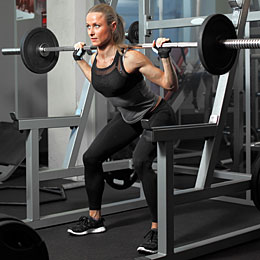 You have no doubt heard that squats are the king of leg exercises, and for good reason. However, squats are not only the top leg building exercise, they also strengthen all the core and stabilizing muscles throughout the upper-body as well.
You have no doubt heard that squats are the king of leg exercises, and for good reason. However, squats are not only the top leg building exercise, they also strengthen all the core and stabilizing muscles throughout the upper-body as well.
Again, there are a number of squat variations (e.g., front squats, dumbbell, etc.) and they can be substituted later to add variety to your workout, but here we will discuss the standard barbell squat:
Stance
As with the deadlift, a wide or narrow stance can be taken as long as you avoid rounding the spine throughout the movement. Your toes can be pointed straight ahead or slightly out, but your knees should track in line with your toes and avoid buckling in or extending past your toes. The bar can be positioned high across the back of the shoulders or slightly further down; choose a position that is comfortable to your body.
Grip
Some people are more flexible in their shoulders than others, so this will determine your grip width. Ideally, you want to be able to bring your hands in as much as possible so you are squeezing your shoulder blades together and creating a solid shelf for the bar to rest on throughout the movement.
Performance
Always try and perform squats in a power rack where you can safely unload the bar onto supports if you don’t have a spotter or get stuck. Step under the bar and position your hands as close as you can, squeezing the shoulder blades together to make that solid shelf to rest the bar on. Lift the bar off the rack, take one step back, and then get your feet in position. Breathe in and create that abdominal and thoracic pressure that will stabilize and protect your spine throughout the movement. Fix your eyes on one spot, about eye-level in front you, and keep your eyes on that spot as you descend to a point where your thighs are parallel to the ground. As with the deadlift, you will be holding your breath through the first three quarters of the movement as you drive up from the heels of your feet, through your thighs and hips and then exhale at the top.
Pull-ups
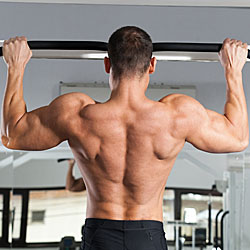 One of the three events in the United State Marine Corps physical fitness test, this exercise was chosen as a standard to measure upper-body strength. If you are saying, “But I can’t even do one pull-up,” no problem, your gym may have a pull-up assist machine that allows you to control the amount of your body weight you pull, or you can use elastic straps or a partner to spot you under crossed feet until you can perform them on your own.
One of the three events in the United State Marine Corps physical fitness test, this exercise was chosen as a standard to measure upper-body strength. If you are saying, “But I can’t even do one pull-up,” no problem, your gym may have a pull-up assist machine that allows you to control the amount of your body weight you pull, or you can use elastic straps or a partner to spot you under crossed feet until you can perform them on your own.
You will be amazed at how fast you improve on this exercise if you stay consistent with it. In fact, once you are able to do between 15-20 pull-ups on your own you can even try to add weight with a dumbbell between your feet or a plate suspended on a chain belt.
Grip
You can perform this exercise with a variety of hand grip widths or an underhand or overhand grip. Overhand and wider grips focus more on back development, while underhand and closer grips emphasize more bicep involvement.
Performance
The key in performing pull-ups is to minimize body swinging and concentrate on pulling your chest straight to the bar. If you are focusing more on back development, in addition to using a wider overhand grip, try to feel the pull coming from the back muscles only, and imagine the arms as just hooks holding you to the bar. However, if you want to shift the emphasis to the biceps using a closer underhand grip, try to keep the back muscles relaxed and really pull with the arms. This ability to create a stronger and more focused contraction in the muscles you are targeting is real, and it is often referred to as the mind to muscle connection. Muscular contractions are the result of electrical impulses at the neuromuscular junction. And these electrical impulses are initiated in the brain. Therefore, it is logical to see how our thoughts, and how we direct them, allow us to focus and control our muscular contractions.
Dips
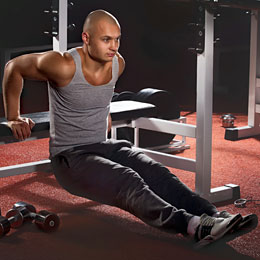 While pull-ups work all the pulling muscles of the upper-body, dips are the perfect complement, as they work all the pushing muscles of the upper-body. And if you cannot perform a dip on your own, the same machine that assists with pull-ups can be used for dips. Likewise, a spotter or elastic bands can be used as well until you have built up enough strength and skill to do them on your own. Just as with pull-ups, if you stay consistent, you will soon be able to perform multiple reps on your and even consider adding weight with a dumbbell or weighted dip belt.
While pull-ups work all the pulling muscles of the upper-body, dips are the perfect complement, as they work all the pushing muscles of the upper-body. And if you cannot perform a dip on your own, the same machine that assists with pull-ups can be used for dips. Likewise, a spotter or elastic bands can be used as well until you have built up enough strength and skill to do them on your own. Just as with pull-ups, if you stay consistent, you will soon be able to perform multiple reps on your and even consider adding weight with a dumbbell or weighted dip belt.
Grip
Wider grips with dips allow for a deeper stretch and emphasis on chest and shoulder development, whereas a closer grip transfers more emphasis to the triceps.
Performance
If you are focusing more on chest and shoulder development, in addition to taking a wider grip, you can also lean your upper-body forward, flare your elbows out to the side, and lift your legs further in front of your body as lower yourself down. You want to go down just far enough till you get a good stretch, but not too far that you experience shoulder pain. Pause for a second at the bottom, then exhale as you push back to the starting position.
If you are trying to emphasize more triceps development, in addition to using a narrower grip, keep your torso vertical and your elbows in at your sides as you descend. Pause for a second at the bottom, then exhale as you push back to the starting position.
Putting it All Together for the Complete Body Workout
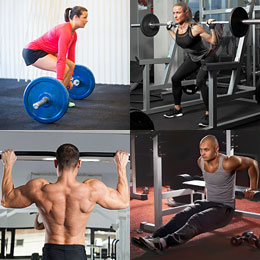 Now that you know the proper form for these prime exercises, it’s time to put them together to maximize the limited time you have.
Now that you know the proper form for these prime exercises, it’s time to put them together to maximize the limited time you have.
If you performed one warm up set of 15 reps followed by 4 sets of 8-10 reps with about 1 ½ minutes rest between sets for each of these four exercises, you could complete a workout in 50 minutes (assuming about 1 minute per set). So there you have it, a complete body workout in under 1 hour!
You can also be creative in how you put these exercises together each workout. For example, one day you might want to do each exercise one at a time for all 5 sets before you move on to the next exercise:
Deadlifts x 5 sets
Squats x 5 sets
Pull-ups x 5 sets
Dips x 5 sets
And another day you may want to do each exercise one after the other in a giant set fashion:
Deadlift, Squat, Pull-ups, Dips in 1 set
Repeat for 4 more sets
When you get more advanced you may even want to try doing these four exercises in a Tabata style workout. If you are not familiar with a tabata workout, it is basically a form of high intensity interval training (HIIT) that involves doing an exercise for as many reps as possible in 20 seconds, then rest for 10 seconds and repeat for a determined number of sets. Using the above four exercises, one example of a tabata style workout could be as follows:
Deadlift as many reps as possible in 20 seconds, rest for 10 seconds then repeat for a total of 8 sets. And then do the same for 8 sets each of squats, pull-ups, and dips. (Note: You will need to use a much lighter weight for deadlifts and squats than you normally do for a regular workout that has more rest time between sets.)
Since you will be training your entire body with these four exercises it would be a good idea to rest about 48 hours between workouts, and make sure you get enough sleep and proper nutrition to recover.
See Also:
About Dax Tucker
Dax Tucker has over 29 years of weight training experience, a black belt in Tae Kwon Do, and is a tournament chess player and yoga practitioner. He also has an MBA, and a BA in psychology. In June of 2011 he released his first published work, "The Leaf Catcher," that is bound to be a modern classic. "The Leaf Catcher" is written in the style of Dante's Divine Comedy and explores and defines the human mind, body, and soul. Dax is currently married with 3 children, and lives in the Pacific Northwest.
